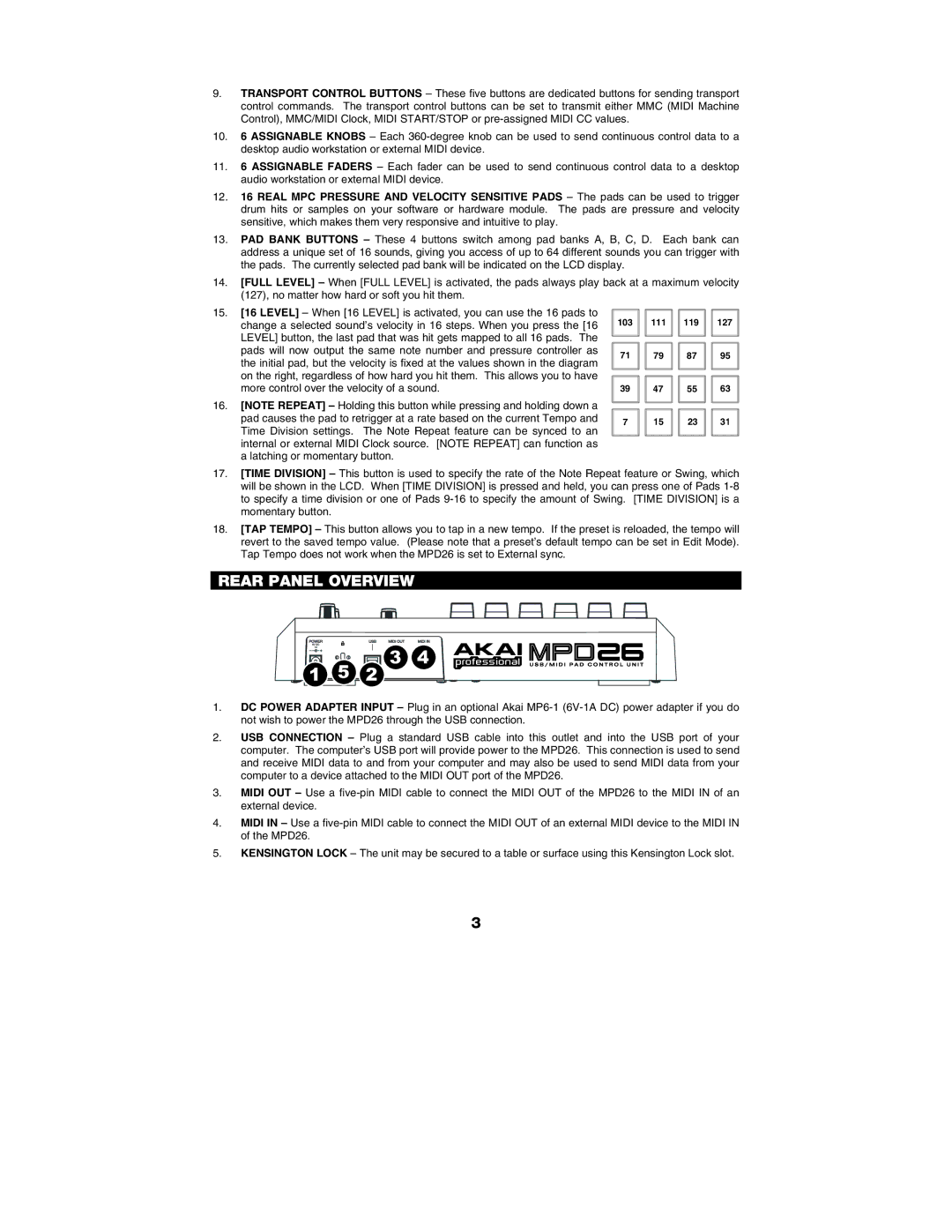
9.TRANSPORT CONTROL BUTTONS – These five buttons are dedicated buttons for sending transport control commands. The transport control buttons can be set to transmit either MMC (MIDI Machine Control), MMC/MIDI Clock, MIDI START/STOP or
10.6 ASSIGNABLE KNOBS – Each
11.6 ASSIGNABLE FADERS – Each fader can be used to send continuous control data to a desktop audio workstation or external MIDI device.
12.16 REAL MPC PRESSURE AND VELOCITY SENSITIVE PADS – The pads can be used to trigger drum hits or samples on your software or hardware module. The pads are pressure and velocity sensitive, which makes them very responsive and intuitive to play.
13.PAD BANK BUTTONS – These 4 buttons switch among pad banks A, B, C, D. Each bank can address a unique set of 16 sounds, giving you access of up to 64 different sounds you can trigger with the pads. The currently selected pad bank will be indicated on the LCD display.
14.[FULL LEVEL] – When [FULL LEVEL] is activated, the pads always play back at a maximum velocity (127), no matter how hard or soft you hit them.
15.[16 LEVEL] – When [16 LEVEL] is activated, you can use the 16 pads to change a selected sound’s velocity in 16 steps. When you press the [16 LEVEL] button, the last pad that was hit gets mapped to all 16 pads. The pads will now output the same note number and pressure controller as the initial pad, but the velocity is fixed at the values shown in the diagram on the right, regardless of how hard you hit them. This allows you to have more control over the velocity of a sound.
16.[NOTE REPEAT] – Holding this button while pressing and holding down a pad causes the pad to retrigger at a rate based on the current Tempo and Time Division settings. The Note Repeat feature can be synced to an internal or external MIDI Clock source. [NOTE REPEAT] can function as a latching or momentary button.
103 111 119 127
71 79 87 95
39 47 55 63
7 |
| 15 |
| 23 |
| 31 |
|
|
|
|
|
|
|
17.[TIME DIVISION] – This button is used to specify the rate of the Note Repeat feature or Swing, which will be shown in the LCD. When [TIME DIVISION] is pressed and held, you can press one of Pads
18.[TAP TEMPO] – This button allows you to tap in a new tempo. If the preset is reloaded, the tempo will revert to the saved tempo value. (Please note that a preset’s default tempo can be set in Edit Mode). Tap Tempo does not work when the MPD26 is set to External sync.
REAR PANEL OVERVIEW
1 | 5 | 2 |
3 | 4 |
1.DC POWER ADAPTER INPUT – Plug in an optional Akai
2.USB CONNECTION – Plug a standard USB cable into this outlet and into the USB port of your computer. The computer’s USB port will provide power to the MPD26. This connection is used to send and receive MIDI data to and from your computer and may also be used to send MIDI data from your computer to a device attached to the MIDI OUT port of the MPD26.
3.MIDI OUT – Use a
4.MIDI IN – Use a
5.KENSINGTON LOCK – The unit may be secured to a table or surface using this Kensington Lock slot.
3
